Bastille Day
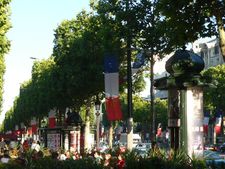
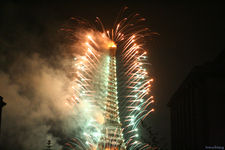
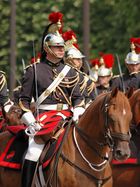
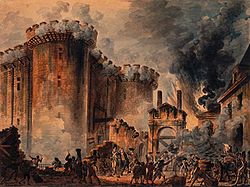
Bastille Day is the French national holiday which is celebrated on 14 July each year. In France, it is formally called La Fête Nationale (The National Celebration) and commonly le quatorze juillet (the fourteenth of July). It commemorates the 1790 Fête de la Fédération, held on the first anniversary of the storming of the Bastille on 14 July 1789; the anniversary of the storming of the Bastille fortress-prison was seen as a symbol of the uprising of the modern nation, and of the reconciliation of all the French inside the constitutional monarchy which preceded the First Republic, during the French Revolution. Festivities are held on the morning of 14 July, on the Champs-Élysées avenue in Paris in front of the President of the Republic.
Contents |
Events and traditions of the day
The parade opens with cadets from the École Polytechnique, Saint-Cyr, École Navale, and so forth, then other infantry troops, then motorized troops; aviation of the Patrouille de France flies above. In recent times, it has become customary to invite units from France's allies to the parade; in 2004 during the centenary of the Entente Cordiale, British troops (the band of the Royal Marines, the Household Cavalry Mounted Regiment, Grenadier Guards and King's Troop, Royal Horse Artillery) led the Bastille Day parade in Paris for the first time, with the Red Arrows flying overhead.[1] In 2007 the German 26th Airborne Brigade led the march followed by British Royal Marines.
The president used to give an interview to members of the press, discussing the situation of the country, recent events and projects for the future. Nicolas Sarkozy, elected president in 2007, has chosen not to give it. The President also holds a garden party at the Palais de l'Elysée.
Article 17 of the Constitution of France gives the President the authority to pardon criminals, and since 1991 the President has pardoned many petty offenders (mainly traffic offences) on 14 July. In 2007, President Sarkozy declined to continue the practice.[2]
History
The storming of the Bastille
On 17 May 1789, Louis XVI convened the Estates-General to hear their grievances. The deputies of the Third Estate representing the common people (the two others were the Catholic Church and nobility) decided to break away and form a National Assembly. On 20 June the deputies of the Third Estate took the Tennis Court Oath, swearing not to separate until a constitution had been established. They were gradually joined by delegates of the other estates; Louis started to recognize their validity on 27 June. The assembly re-named itself the National Constituent Assembly on 9 July, and began to function as a legislature and to draft a constitution.
In the wake of the 11 July dismissal of Jacques Necker, the people of Paris, fearful that they and their representatives would be attacked by the royal military, and seeking to gain ammunition and gunpowder for the general populace, stormed the Bastille, a fortress-prison in Paris which had often held people jailed on the basis of lettres de cachet, arbitrary royal indictments that could not be appealed. Besides holding a large cache of ammunition and gunpowder, the Bastille had been known for holding political prisoners whose writings had displeased the royal government, and was thus a symbol of the absolutism of the monarchy. As it happened, at the time of the siege in July 1789 there were only seven inmates, none of great political significance.
When the crowd—eventually reinforced by mutinous gardes françaises—proved a fair match for the fort's defenders, Governor de Launay, the commander of the Bastille, capitulated and opened the gates to avoid a mutual massacre. However, possibly because of a misunderstanding, fighting resumed. Ninety-eight attackers and just one defender died in the actual fighting, but in the aftermath, de Launay and seven other defenders were killed, as was the 'prévôt des marchands' (roughly, mayor) Jacques de Flesselles.
The storming of the Bastille was more important as a rallying point and symbolic act of rebellion than a practical act of defiance.
Shortly after the storming of the Bastille, on 4 August feudalism was abolished and on 26 August, the Declaration of the Rights of Man and of the Citizen proclaimed.
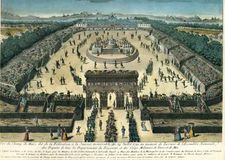
The Fête de la Fédération
The Fête de la Fédération of the 14 July 1790 was a huge feast and official event to celebrate the uprising of the short-lived constitutional monarchy in France and what people considered the happy conclusion of the French Revolution. The event took place on the Champ de Mars, which was at the time far outside Paris. The place had been transformed on a voluntary basis by the population of Paris itself, in what was recalled as the Journée des brouettes ("Wheelbarrow Day").
A mass was celebrated by Talleyrand, bishop of Autun. The popular General Lafayette, as captain of the National Guard of Paris and confidant of the king, took his oath to the constitution, followed by the King Louis XVI. After the end of the official celebration, the day ended in a huge four-day popular feast and people celebrated with fireworks, as well as fine wine and running naked through the streets in order to display their great freedom.
Origin of the present celebration
On 30 June 1878, a feast had been arranged in Paris by official decision to honour the French Republic (the event was commemorated in a painting by Claude Monet). On the 14 July 1879, another feast took place, with a semi-official aspect; the events of the day included a military review in Longchamp, a reception in the Chamber of Deputies, organised and presided over by Léon Gambetta, and a Republican Feast in the Pré Catelan with Louis Blanc and Victor Hugo. All through France, as Le Figaro wrote on the 16th, "people feasted much to honour the Bastille".
On the 21 May 1880, Benjamin Raspail proposed a law to have "the Republic choose the 14 July as a yearly national holiday". The Assembly voted the text on 21 May and 8 June. The Senate approved on 27 and 29 June, favouring 14 July against 4 August (honouring the end of the feudal system on 4 August 1789). The law was made official on 6 July 1880, and the Ministry of the Interior recommended to prefects that the day should be "celebrated with all the brilliance that the local resources allow". Indeed, the celebrations of the new holiday in 1880 were particularly magnificent.
In the debate leading up to the adoption of the holiday, Henri Martin, chairman of the French Senate, addressed that chamber on 29 June 1880. "Do not forget that behind this 14 July, where victory of the new era over the ancien régime was bought by fighting, do not forget that after the day of 14 July 1789, there was the day of 14 July 1790. ... This [latter] day cannot be blamed for having shed a drop of blood, for having divided the country. It was the consecration of the unity of France. ... If some of you might have scruples against the first 14 July, they certainly hold none against the second. Whatever difference which might part us, something hovers over them, it is the great images of national unity, which we all desire, for which we would all stand, willing to die if necessary."
Bastille Day Military Parade
The Bastille Day Military Parade is the French military parade that has been held on the morning of 14 July each year in Paris since 1880.
The parade passes down the Champs-Elysées from the Arc de Triomphe to the Place de la Concorde where the President of the French Republic, his government and foreign ambassadors to France are standing. This is a popular event in France, broadcast on French TV, and is the oldest and largest regular military parade in the world. In some years, invited detachments of foreign troops take part in the parade and foreign statesmen attend as guests.
Smaller military parades are held in French garrison towns, including Toulon and Belfort, with local troops.
Bastille Day celebrations in other countries
-
- Liège celebrates the Bastille Day each year since the end of the First World War, as Liège was decorated by the Légion d'Honneur for its unexpected resistance during the Battle of Liège.
-
- Franschhoek's week-end festival[4] has been celebrated for the last 15 years. (Franschhoek, or 'French Corner,' is situated in the Western Cape.)
Over 50 U.S. cities conduct annual celebrations [6]
-
- Baltimore has a large Bastille Day celebration each year at Petit Louis in the Roland Park area of Baltimore City.
- Chicago has hosted a variety of Bastille Day celebrations in a number of locations in the city, including Navy Pier and Oz Park. The recent incarnations have been sponsored in part by the Chicago branch of the French-American Chamber of Commerce and by the French Consulate-General in Chicago.
- Milwaukee's four-day [1] street festival begins with a "Storming of the Bastille" with a 43-foot replica of the Eiffel Tower.
- Minneapolis has a celebration in Uptown with wine, French food, pastries, a flea market, circus performers and bands.
- New Orleans has multiple celebrations, the largest in the historic French Quarter.[7]
- New York City has a large Bastille Day celebration each year on 60th Street on the Upper East Side of Manhattan, and the Empire State Building is illuminated in blue, white and red.
- Orlando has a boutique Bastille Day street festival that began in 2009 in the Audubon Park Garden District and involves champagne, wine, music, petanque, artists, and street performers.
- Philadelphia's Bastille Day, held at Eastern State Penitentiary, involves Marie Antoinette throwing locally manufactured pastries at the Parisian militia, as well as a re-enactment of the storming of the Bastille.[8]
- San Francisco has a large celebration in the downtown historic French quarter.
- Seattle's Bastille Day Celebration, held at the Seattle Center, involves performances, picnics, wine and shopping.
One-time celebrations
- 1979: A concert with Jean-Michel Jarre on the Place de la Concorde in Paris attracted one million people, securing an entry in the Guinness Book of Records for the largest crowd at an outdoor concert.
- 1989: France celebrated the 200th anniversary of the French Revolution, notably with a monumental show on the Champs-Élysées in Paris, directed by French designer Jean-Paul Goude. President François Mitterrand acted as host for invited world leaders.
- 1990: A concert with Jean-Michel Jarre was held at La Défense in Paris.
- 1995: A concert with Jean-Michel Jarre was held at the Eiffel Tower in Paris.
- 1998: Two days after the French football team became world champions, huge celebrations took place nationwide.
- 2004: To commemorate the centenary of the Entente Cordiale, the British led the military parade with the Red Arrows flying overhead.
See also
- Bastille Day Military Parade
- Opération 14 juillet
- Public Holidays in France
Notes
- ↑ http://www.entente-cordiale.org/en/6a_c.php?id=1
- ↑ Sarkozy enterre la grâce présidentielle du 14 juillet plus news.fr
- ↑ http://www.budapestresources.com/node/447
- ↑ Bastille Day Festival at Franschhoek
- ↑ http://www.viewlondon.co.uk/whatson/bastille-day-london-feature-1130.html
- ↑ http://bastilledaymap.com/ :: Interactive Map Bastille Day Locations in the U.S.
- ↑ http://www.nola.com/news/index.ssf/2009/07/only_in_new_orleans_watch_loca.html
- ↑ ESP :: Eastern State Penitentiary Website
External links
- Tout savoir sur le 14 Juillet
- Bastille Day history
- Bastille Day at the French Embassy in London 2008
- Bastille Day in New York 2006
- Bastille Day Celebration
|
|||||||||||||||||||||||||||||||||||||||||||||||||||||||||||||||||||||||||||||||||||||||||||||||||||||||||||||||||||||||||||||||||||||||||||||||||||
